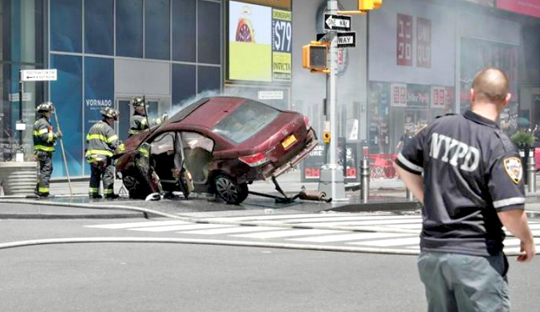Washington, May 19: A US Navy veteran plowed his car into pedestrians in New York City's packed Times Square on Thursday, killing an 18-year-old woman and injuring 22 people. The city's mayor said there was no indication it was an act of terrorism.

Witnesses said the motorist mounted the sidewalk in a burgundy Honda sedan and sped along for more than three city blocks, knocking people over before the car hit a pole and came to rest at 45th Street and Broadway in Midtown Manhattan.
Police who took the driver into custody identified him as Richard Rojas, 26, of the New York City borough of the Bronx. They said he had been arrested twice for drunken driving in 2008 and 2015, and once earlier this month on a charge of menacing.
There was no indication it was an act of terrorism, Mayor Bill de Blasio told a news conference at the scene.
Initial reports of the incident brought to mind vehicle attacks on pedestrians in recent months in Britain, France, Germany, Israel and Sweden.
Security camera footage showed the car slam into pedestrians who moments earlier were ambling along, some carrying shopping bags and others pushing baby strollers.
The incident took place close to noon on a bright, sunny day.
"People were being hit and rolling off the car," said Josh Duboff, who works at the nearby Thomson Reuters headquarters. He leaped out of the way to avoid being struck. Shoes were scattered on the sidewalk. A woman's body lay covered with a bloodstained blanket. A police officer kept vigil nearby, sadly shaking his head.
The dead woman was named by police as Alyssa Elsman, an 18-year-old who was on vacation with her family from Michigan. Hundreds of thousands of people, many of them tourists from around the world, pass daily through Times Square, the heart of the Broadway theatre district.
The bustling streets are heavily patrolled by police, some on horseback. Many, but not all, sidewalks are lined with barricades and planters for fear of vehicle attacks. A bouncer from the Planet Hollywood restaurant and a ticket agent were among onlookers who helped police subdue the suspect when he tried to flee the scene, media reports said.
Broadway shows would go ahead as planned on Thursday evening in the many theatres in the area, organizers said in a statement.
'Mowed everyone down'
Navy records show that Rojas enlisted in September 2011 and was based in Illinois and Florida, working as an electrician's mate fireman apprentice.
He was arrested a year later at a naval base in Jacksonville, Florida, where officials said he attacked a cab driver, shouted "my life is over," and threatened to kill police, according to court records. Rojas was charged with misdemeanour battery and resisting an officer without violence, but it was unclear how the case was resolved.
Navy records show he spent two months in a military prison in Charleston, South Carolina, in the summer of 2013, but did not say why. He left the Navy in May 2014.
Quoting unnamed police sources, ABC News said Rojas had apparently been high on synthetic marijuana when he crashed into his victims on Thursday. Initial tests came back negative for alcohol, the law enforcement sources told ABC News.
After the incident, authorities cordoned off an area from 41st to 47th streets and from Sixth to Eighth avenues for several hours, effectively shutting down one of the busiest parts of one of the busiest cities in the world.
The crash occurred outside the headquarters of the Reuters news agency, 3 Times Square. Building foreman Rodney Muir said he heard what sounded like a big bang and crunching metal. He said he looked out and saw what appeared to be a body in the street.
One of the injured, Cheryl Howard, had blood dripping down her right arm and a bruise above her left eye. She and her daughter were shopping when the car sped toward them. "I'm so freaked out!" Howard's daughter said. "They mowed everyone down."
Times Square was evacuated in May 2010 when a car bomb that failed to explode was found in an SUV. Faisal Shahzad, a naturalized American and Taliban-trained militant, later pleaded guilty and was sentenced to life imprisonment.
Six months ago the city completed a $55 million, nearly six-year renovation of Times Square that turned roadways into pedestrian zones. It aimed to improve congestion and safety, but not all sidewalks were fitted with safety bollards.





Comments
Add new comment